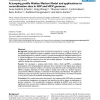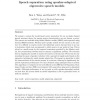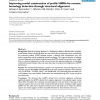BMCBI
2006
2006
A jumping profile Hidden Markov Model and applications to recombination sites in HIV and HCV genomes
14 years 10 days ago
Background: Jumping alignments have recently been proposed as a strategy to search a given multiple sequence alignment A against a database. Instead of comparing a database sequen...
CSL
2010
Springer
14 years 11 days ago
2010
Springer
We present a system for model-based source separation for use on single channel speech mixtures where the precise source characteristics are not known a priori. The sources are mo...
BMCBI
2008
14 years 12 days ago
2008
In this paper we present preliminary results stemming from a novel application of Markov Models and Support Vector Machines to splice site classification of Intron-Exon and Exon-I...
BMCBI
2007
14 years 12 days ago
2007
Background: Remote homology detection is a challenging problem in Bioinformatics. Arguably, profile Hidden Markov Models (pHMMs) are one of the most successful approaches in addre...
BMCBI
2010
14 years 13 days ago
2010
Background: Existing hidden Markov model decoding algorithms do not focus on approximately identifying the sequence feature boundaries. Results: We give a set of algorithms to com...
NIPS
2007
14 years 1 months ago
2007
We investigate a family of inference problems on Markov models, where many sample paths are drawn from a Markov chain and partial information is revealed to an observer who attemp...
LREC
2008
14 years 1 months ago
2008
Part-of-Speech tagging is generally performed by Markov models, based on bigram or trigram models. While Markov models have a strong concentration on the left context of a word, m...
CMMR
2008
Springer
14 years 2 months ago
2008
Springer
Abstract. This paper describes a method for labelling structural parts of a musical piece. Existing methods for the analysis of piece structure often name the parts with musically ...
Publication
We present a class of models that, via a simple construction,
enables exact, incremental, non-parametric, polynomial-time,
Bayesian inference of conditional measures. The approac...
APWEB
2003
Springer
14 years 4 months ago
2003
Springer
People display regularities in almost everything they do. This paper proposes characteristics of an idealized algorithm that would allow an automatic extraction of web user profil ...





